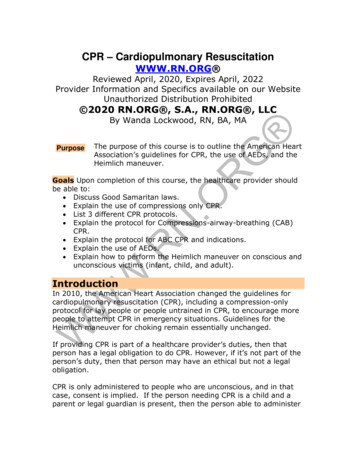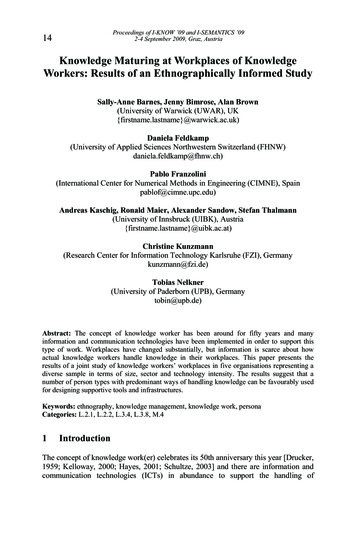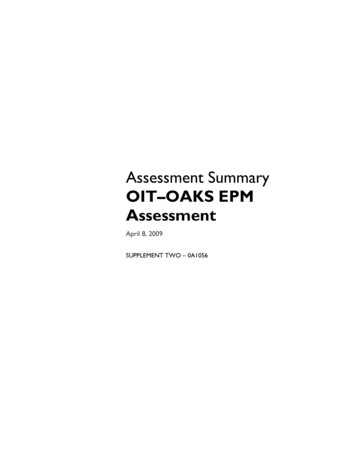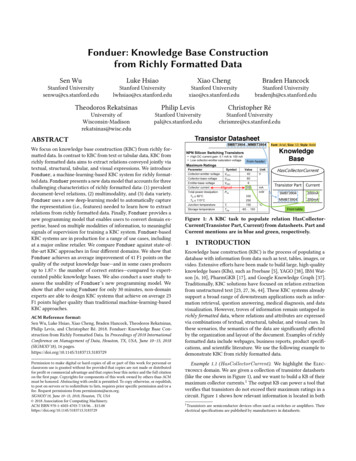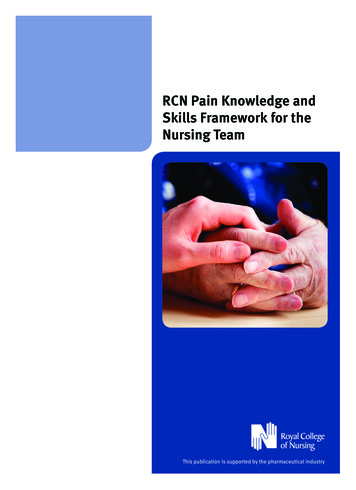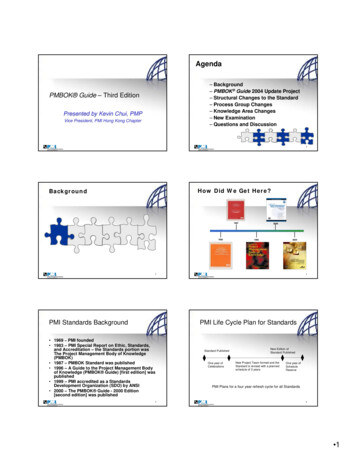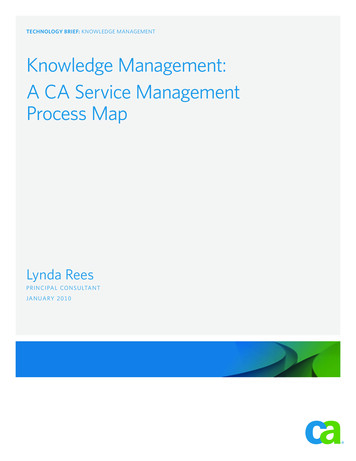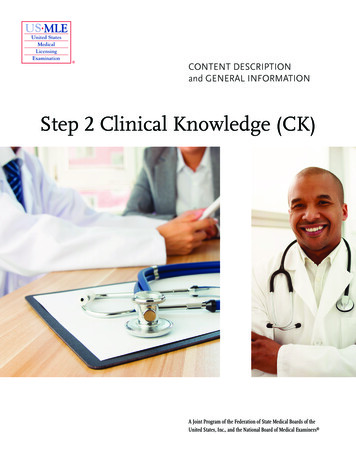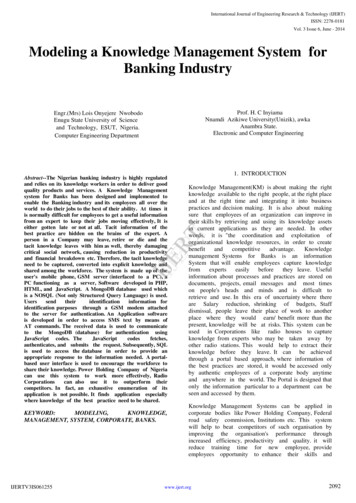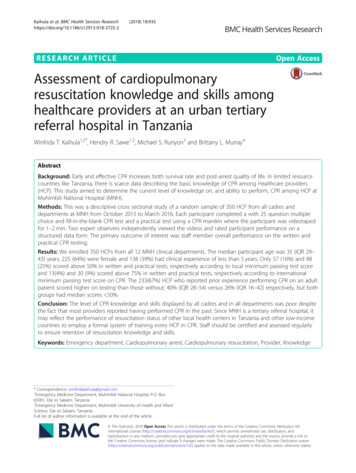
Transcription
Kaihula et al. BMC Health Services 2018) 18:935RESEARCH ARTICLEOpen AccessAssessment of cardiopulmonaryresuscitation knowledge and skills amonghealthcare providers at an urban tertiaryreferral hospital in TanzaniaWinfrida T. Kaihula1,2*, Hendry R. Sawe1,2, Michael S. Runyon3 and Brittany L. Murray4AbstractBackground: Early and effective CPR increases both survival rate and post-arrest quality of life. In limited resourcecountries like Tanzania, there is scarce data describing the basic knowledge of CPR among Healthcare providers(HCP). This study aimed to determine the current level of knowledge on, and ability to perform, CPR among HCP atMuhimbili National Hospital (MNH).Methods: This was a descriptive cross sectional study of a random sample of 350 HCP from all cadres anddepartments at MNH from October 2015 to March 2016. Each participant completed a with 25 question multiplechoice and fill-in-the-blank CPR test and a practical test using a CPR manikin where the participant was videotapedfor 1–2 min. Two expert observers independently viewed the videos and rated participant performance on astructured data form. The primary outcome of interest was staff member overall performance on the written andpractical CPR testing.Results: We enrolled 350 HCPs from all 12 MNH clinical departments. The median participant age was 35 (IQR 29–43) years, 225 (64%) were female and 138 (39%) had clinical experience of less than 5 years. Only 57 (16%) and 88(25%) scored above 50% in written and practical tests, respectively according to local minimum passing test scoreand 13(4%) and 30 (9%) scored above 75% in written and practical tests, respectively according to internationalminimum passing test score on CPR. The 233(67%) HCP who reported prior experience performing CPR on an adultpatient scored higher on testing than those without; 40% (IQR 28–54) versus 26% (IQR 16–42) respectively, but bothgroups had median scores 50%.Conclusion: The level of CPR knowledge and skills displayed by all cadres and in all departments was poor despitethe fact that most providers reported having performed CPR in the past. Since MNH is a tertiary referral hospital, itmay reflect the performance of resuscitation status of other local health centers in Tanzania and other low-incomecountries to employ a formal system of training every HCP in CPR. Staff should be certified and assessed regularlyto ensure retention of resuscitation knowledge and skills.Keywords: Emergency department, Cardiopulmonary arrest, Cardiopulmonary resuscitation, Provider, Knowledge* Correspondence: winfridakaihula@gmail.com1Emergency Medicine Department, Muhimbili National Hospital, P.O. Box65001, Dar es Salaam, Tanzania2Emergency Medicine Department, Muhimbili University of Health and AlliedScience, Dar es Salaam, TanzaniaFull list of author information is available at the end of the article The Author(s). 2018 Open Access This article is distributed under the terms of the Creative Commons Attribution 4.0International License (http://creativecommons.org/licenses/by/4.0/), which permits unrestricted use, distribution, andreproduction in any medium, provided you give appropriate credit to the original author(s) and the source, provide a link tothe Creative Commons license, and indicate if changes were made. The Creative Commons Public Domain Dedication o/1.0/) applies to the data made available in this article, unless otherwise stated.
Kaihula et al. BMC Health Services Research(2018) 18:935BackgroundEarly recognition and intervention in cardiac arrest saveslives [1], For every minute without cardiopulmonary resuscitation (CPR) and defibrillation, the victim’s chanceof survival from cardiac arrest decreases by 7–10% [2].CPR is now modified into a simple version of skills thatcan be learned by anyone regardless of formal medicaltraining [3]. In the hospital, this allows any trained staffmember to rapidly initiate this live saving treatment [4].In the developed world, the incidence of in-hospitalcardiac arrest attended by a resuscitation teams and receiving CPR is approximately 2 per 1000 admissions [5].In such settings, the training of staff members and theintroduction of resuscitation teams and pre-employmentrequirements of CPR certification have resulted in improvement of outcomes of in-hospital cardiac arrest [6].In developing countries there is limited published dataon the incidence, organization and outcomes ofin-hospital CPR [7]. Furthermore, in most parts of Africa, studies have shown health care providers (HCPs) tohave poor knowledge and skills of CPR despite attempting to do resuscitation [8–10].Since CPR is a very important skill, HCPs, irrespectiveof their training level or work setting should be competent in initiating and performing CPR, and hospitalsshould provide training to their staff [11, 12]. The knowledge of CPR amongst HCPs is significantly influencedby training [13] and it is a major determinant of the success of CPR [14]. To acquire this knowledge, routinetraining on CPR should be emphasized [15]. International recommendations dictate that HCPs repeat aCPR course at least every 2 years [14–16]. In many developing countries, standard resuscitation training is notroutine [14, 17]. In fact, it is often simply assumed thatall HCPs have the ability to recognize and treat cardiopulmonary arrest [18]. In Tanzania, the current knowledge and ability to perform CPR among HCPs isunknown.This study aimed to determine the CPR knowledge,skills, and training among HCPs at Muhimbili NationalHospital (MNH). The hope is that an improved understanding of current state of CPR knowledge and skillamong these providers will help guide future trainingand the implementation of strategies that will benefithealthcare delivery to patients with cardiopulmonary arrest in low resource in-hospital settings.Page 2 of 8Study setting and populationMNH is a National referral hospital with 1500-beds thatreceives patients from all over Tanzania. The Hospitalhad annual volume of 446,000 outpatients, 60,000 emergency department patients, and 53,000 admissions togeneral wards. The annual theater use is around 13,000patients, while approximately 220 patients are admittedto Intensive Care Units annually [19]. At the time of thestudy, MNH had 2326 HCPs employed in the in-patientsetting at the time of this study.A sample of 350 staff representing 15% all staff providing inpatient care (which also represents 15% of eachcadre in their respective departments) were randomly invited and consented to participate in the study during6-month period of data collection. Cadres included healthattendants, nurses, interns, registrars (general practitioners), residents (doctors in specialty training), specialists, and supporting clinical staff. Departments includedthe 11 major departments of MNH, and the intern doctorsas a separate ‘department’ because they have their ownclassification within the hospital management scheme.Study protocolEach participant completed a questionnaire that detailedbasic demographics, clinical experience, and level of training, work site, Basic Life Support (BLS) /CPR certificationand periodicity of BLS/CPR courses. Each participant thencompleted a 25 question multiple choice andfill-in-the-blank test (Additional file 1) which is derivedfrom the American Heart Association (AHA) BLS test andmodified to reflect local terminology and resources [1].Each participant also completed a practical test using CPRmanikins where the participant was videotaped for 1–2 min(Additional file 2). Two expert observers independentlyviewed the videos and used a structured data form, basedon AHA practical skills testing and modified to local resource availability, to rate participant performance of practical skills, including the initial approach and compressionand ventilation techniques (Additional file 3). Both themultiple-choice test and video observation checklist werepiloted on a small group of registrars from the ED whowere not participants in the study for feedback before implementation. The individual scores from the multiple-choicetest and video observation were assessed independently andalso combined to produce an overall score.Key outcome measuresMethodsStudy designThis was a descriptive cross sectional study conductedat Muhimbili National Hospital (MNH) in Dar es Salaam, Tanzania from October 2015 to March 2016.MNH is the national referral hospital.The primary outcome of interest was staff member performance on written and practical CPR testing. Secondary outcomes included the relation of the performanceon testing to the participant work sites; self reportedknowledge on CPR, clinical experience and formal CPRcertification and training status.
Kaihula et al. BMC Health Services Research(2018) 18:935Data analysisStudy data were entered in to an Excel database (MicrosoftCorporation, Redmond, Washington, USA) and analyzedwith StatsDirect version 3.0.133 (StatsDirect Ltd., Cheshire,UK). Descriptive statistics, including counts (percentages)and medians (interquartile ranges [IQR]) are reported asappropriate. Comparisons among groups were performedusing the Chi Square or Fisher’s exact test for proportionsand the Kruskal-Wallis test, with post hoc pairwise testingaccording to the Dwass-Steel-Critchlow-Fligner procedureas indicated, for continuous variables. Two-sided p-values 0.05 were considered significant. Inter-observer agreement for scoring of the video performances was quantifiedwith the Cohen’s Kappa.CPR knowledge scores were divided into three categories:The Muhimbili University and Allied Sciences (MUHAS)minimum passing criteria of 50% [20], the UK ResuscitationCouncil minimal passing score of 75% [21], and the AHAminimal passing score of 84%. These comparisons weremade to compare the local performance to local and international standards for CPR competency of HCP.Page 3 of 8Table 1 Demographics of study participantsAge in years (median)35 (IQR 29–43)GenderN 350FemaleCadre225 (64%)N 350Specialist39 (11%)Resident37 (11%)Registrar15 (4.2%)Intern19 (5.4%)Nurses158 (45%)Health attendant68 (19.4%)Supporting clinical staff14 (4%)DepartmentN 350Anesthesia/ICU/OT32 (9.1%)Cardiovascular24 (7%)Diagnostic and laboratory19 (5.4%)Emergency medicine25 (7%)General surgery41 (12%)Intern19 (5.4%)ResultsInternal medicine39 (11.1%)DemographicsObstetrics/Gynecology51 (15%)Pediatrics40 (11%)Psychiatry19 (5.4%)Radiology19 (5.4%)Surgical specialties22 (6.2%)A total of 350 participants from 12 MNH departmentswere selected and all responded by answeringself-administered questionnaires and demonstrating practical aspects of CPR on a manikin. The median participantage was 35 (IQR 29–43) years, 225 (64%) were female and138 (39%) had clinical experience of less than 5 years(Table 1). Inter-observer agreement for rating of participant performance by video review and completion of thestructured scoring checklist revealed and observed agreement of 87% and a corresponding Cohen’s Kappa of 0.69.Years of clinical practiceN 350Less than 5 years156 (44%)5 to 10 years104 (30%)More than 10 years90 (26%)Reported CPR experience and trainingInitial approachA total of 233 (67%) participants reported to have previously performed CPR on an adult patient; of these, 108(46%) reported to have done CPR 1–3 times in the past1 month. There was a significant difference in the overallperformance on testing between those who had and hadnot performed CPR in the past with median test scoresof 40%(IQR 28–54) and 26%(IQR 16–42) respectively, p 0.001 (Table 2). Overall, 239 (68%) of participants reported to have prior knowledge on CPR and 155 (44%)reported to have had prior formal adult BLS/CPR training. There was a significant difference in testing scoresbetween those with and without prior training with median test scores of 46% (IQR 36–58) and 26% (IQR 18–40) respectively, p 0.001 (Table 2). With regards totime in clinical practice, the overall performance on testing was better among those with less than 10 years clinical experience compared to those with experience morethan 10 years (p 0.0001) (Table 2).The combined total score on initial approach (writtenand practical) among doctors was significantly higherthan other cadres with no significance difference between the subgroups of doctors. Intern doctors scoredhigher, while health attendants followed by supportingclinical staff scored lower than other cadres (Fig. 1a).CompressionsThe combined total score on compressions (written andpractical) among doctors was significantly higher thanother cadres with no significance difference betweentheir subgroups. Intern doctors and registrars scoredhigher, while supporting clinical staff followed by healthattendants scored lower than other cadres (Fig. 1b).VentilationThe combined total score on ventilation components(written and practical) among doctors was significantly
Kaihula et al. BMC Health Services Research(2018) 18:935Page 4 of 8Table 2 Baseline CPR training, CPR experience, and test scoresNumber of participantsPerformance of CPRTotal test score median (IQR) %N 350P 0.001*Performed CPR in lifetime233 (67%)40 (IQR 28–54)Has never performed CPR117 (33%)26 (IQR 16–42)Performance in the past 1 month- NoneN 23398 (42%)37 (IQR 27–52)- 1–3 times108 (46%)42 (IQR 30–56)- 4–6 times21 (9%)46 (IQR 34–61)- 6 times6 (3%)41 (IQR 37–60)Reported knowledge on CPRN 350Yes239 (68%)40 (IQR 28–54)111 (32%)26 (IQR 18–37)N 350P 0.001*Yes155 (44%)46 (IQR 36–58)No195 (56%)26 (IQR 18–40)How long ago?N 155Less than 1 year58 (37.4%)48 (IQR 37–58)Less than 5 years58 (37.4%)47 (IQR 38–60)More than 5 years39 (25.2%)44 (IQR 34–53)Years of clinical practiceP 0.34**T 3.33P 0.001*NoPrior formal BLS trainingDifference between groupsN 350Less than 5 years156 (44%)42 (IQR 28–52)5 to 10 years104 (30%)40 (IQR 28–54)More than 10 years90 (26%)26 (IQR 18–36)aP 0.29**T 2.41P 0.0001**T 35.43*Mann-Whitney test**Kruskal-Wallis testaPost hoc analysis shows that there is no significant difference between the Less than 5 year group and the 5 to 10 year group, but that the More than 10 yeargroup scored significantly lowerhigher than other cadres with no significance differencebetween their subgroups. Registrars scored higher, whilesupporting clinical staff and health attendants scoredlower than other cadres (Fig. 1c).Knowledge by departmentInitial approachThe combined total score on initial approach components (written and practical) was significantly higher forthe ED than other departments, with no significance difference between the scores of the departments whencompared with each other (Fig. 2a).with no significance difference between the other departments when compared with each other (Fig. 2c).Overall knowledge among HCPFor the overall scores, 280 (80%) and 232 (66%) participants scored 50% in written and practical testing respectively. Only 13 (4%) and 30 (9%) participants scored 75%in written and practical testing respectively. Individualscores for components pertaining to initial approach,chest compression and ventilation are shown in Table 3.Defibrillator useCompressionThe combined total score on compressions components(written and practical) among doctors was significanthigher for the ED than other departments, with no significance difference between the other departmentswhen compared with each other (Fig. 2b).VentilationThe combined total score on ventilation components(written and practical) among doctors was significantlyhigher for the ED and anaesthesia than other departments,A total of 197 (56%) participants reported familiaritywith defibrillators, but no prior training in their use.Among these, 73 (37%) knew that defibrillation increasesurvival and only 6 (3%) asked for a defibrillator in practical skills testing. Of the 69 (20%) participants reportedto have received prior training on defibrillator use, 25(36%) knew that defibrillation can increase survival, and3 (4%) asked for a defibrillator in practical skills testing.Of the 85 (24%) of all participants who reported havinga defibrillator in their respective departments, only 4(5%) asked for it in practical skills testing.
Kaihula et al. BMC Health Services Research(2018) 18:935Page 5 of 8AABBCFig. 1 a Combined written and practical test scores of participantsamong different cadres on initial approach of cardiac arrest. b Combinedwritten and practical test scores of participants among different cadreson principals of chest compression to the victim of cardiac arrest. cCombined written and practical test scores of participants amongdifferent cadres on principals of ventilation to the victim of cardiac arrestDiscussionTo the best of our knowledge this is the first study ofknowledge on, and ability to perform CPR amongst HCPsof different cadres in Sub-Saharan Africa. Of the participants, 44% had clinical experience of less than 5 years. AsHCP should be taught resuscitation skills in school, it maybe expected of them to perform better. However this wasnot shown to be the case as they performed poorly on theCFig. 2 a Combined written and practical test scores of participantsamong different departments on initial approach of cardiac arrest. bCombined written and practical test scores of participants amongdifferent departments on principals of chest compression to thevictim of cardiac arrest. c Combined written and practical test scoresof participants among different departments on principals ofventilation to the victim of cardiac arresttests, this may be due to not being trained in resuscitationskills during school or from loss of skills due not practicing them. It was also shown in this study that there wasno association between duration of clinical experience and
Kaihula et al. BMC Health Services Research(2018) 18:935Table 3 Test scores of all healthcare providersScore 50%N (%)Score 50–74%N (%)Score 75%N (%)Written test223 (64%)90 (26%)37 (10%)Practical test244 (70%)67 (19%)39 (11%)Written test268 (77%)57 (16%)25 (7%)Practical test137 (39%)140 (40%)73 (21%)Written test182 (52%)95 (27%)73 (21%)Practical test215 (61%)105 (30%)30 (9%)Written test280 (80%)57 (16%)13 (4%)Practical test232 (66%)88 (25%)30 (9%)Test componentInitial approach (N 350)Compressions (N 350)Ventilation (N 350)Total scores (N 350)performance of CPR as there was no significance difference between participants who worked for less than 5years and those between 5 and 10 years, which is a similarfinding as in other studies [11, 22]. This suggests thatthere is not adequate basic life support training in schoolcurricula. This also suggests that there is absence of continual in-service training that might have helped in improving HCP knowledge as seen in other studies [23, 24].Though participants reported to have prior knowledge onCPR performance, their performance was poor overall.However, despite their poor performance, they still had significantly higher test scores than those who reported not tohave knowledge of CPR. Participants who reported to haveperformed CPR infrequently have demonstrated poor performance. Infrequent performance of CPR has been shownto be associated with poor ability to retain CPR skills, andthis may account for this finding [11]. Among participants,less than 50 % self-reported to have prior formal adult BLS/CPR training, with less than 40 % reporting to have thetraining in the last year. Though the performance is overallpoor, this group scored higher than those without priortraining. Again, previous studies have demonstrated an association between poor performance and lack of formal CPRtraining [23, 24]. This suggests that we must emphasize resuscitation programs and continual skill renewal programsin order to improve resuscitation skills [25].The health attendants performed poorly on both testsand this may be explained by their limited role in patientcare. Typically health attendants transport patients and assist nurses; and are often asked to help in emergency situations hence training in this group needs to be emphasized.Nurses likewise performed poorly on both the written andpractical test. This poor performance is alarming as studieshave shown nurses to often be the first responders to emergency situations in the wards [17, 22] and so trainingshould also be emphasized among this cadre. Doctors ingeneral performed poorly with a total score of 50%.Page 6 of 8Surprisingly, intern doctors performed better than specialistdoctors on the written test and registrars performed betterthan specialist on the practical test. As specialists are seniorand 64% reported to have received formal training on BLS/CPR, it was anticipated of them to perform best of all HCP.Interns on the other hand might have performed bettersince they have rotated in the ED where they have been exposed to CPR training and trained and practice.Between the departments, the ED has been shown to perform better on combined score of the test. This may be explained by their regular involvement in resuscitation andtraining as compared to other departments. In fact, regulartraining and involvement has been found to improve CPRknowledge and performance in other settings, such as workby Parajulee et al. who showed that among nurses therewas and association between worksite and total scores ofparticipants due to training and experience [22].As the local premier University of health in Tanzania thestandard for passing is above 50% [24], 80% of HCP wouldhave failed on the written test and 66% would have failed onthe practical test as they scored less than 50%. However ifwe use international standard for passing score as a reflection of competency in BLS/CPR practice example the UKresuscitation council where the minimal passing score is 75 [25] and for AHA 84% [20], less than 10% of HCPwould have passed the test and been considered competent.Appropriate approach to cardiac arrest is known toimpact the overall outcome of patients with cardiac arrest [26]. In our study, all HCP performed poorly on thewritten and practical assessment on the initial approach,with less than one third of HCP correctly identifying theimportance of scene safety, checking for responsivenessand calling for help. These observations are similar towhat has been reported in other low-and-middle incomecountries [27, 28], and contrary to findings of similarstudies in high-income countries [29].During CPR, correct technique of ventilation is key to assuccesses return of spontaneous circulation [30] interestingly the HCPs in our study population demonstrated abetter score in written compared to other evaluated components of CPR. These findings of better theoretical knowledge may be a result of the fact that the old CPRguidelines prioritized teaching on airway (A) and breathing(B) above Circulation (C) in the approach to cardiac arrestassessment and management (the A-B-C approach) beforethe change to prioritizing Circulation above Airway andBreathing (the C-A-B approach). This observation wasfurther supported by the performance in the practicalassessment where nearly two-third of HCP delayedinitiation of CPR while assessing and managing airwayand breathing issues and performing prolonged pulsechecks. The implication of this finding is that theMNH HCP does not seem to have received updatedtraining on current CPR guidelines.
Kaihula et al. BMC Health Services Research(2018) 18:935Though more than half of HCP reported to have knowledge of defibrillator use, only 37% knew that defibrillationincreases chances of survival of a victim of cardiac arrestand less than 5 % actually called for it during practical aspect of CPR. This is an important knowledge gap as it hasbeen shown that for every minute without CPR and defibrillation, the victim’s chance of survival from cardiac arrestdecreases by 7 to 10% [2, 4]. Only 20% of HCP reportedprior training in defibrillation and only 24% of HCP have adefibrillator in their departments. This lack of defibrillatoraccess and training may contribute to suboptimal resuscitation efforts and increased mortality.LimitationsThis is a single centered study done at the National Hospital, which may not be representative of other healthcare facilities in the region. Although the written testand practical skills testing checklist were not previouslyvalidated, the questionnaire and practical testing weredesigned based on published guidelines and were pilotedlocally prior to implementation. In fact, interobserveragreement was good between the expert observers whoindependently reviewed the videotapes and rated participant performance according to a standardized checklist.It was said by the HCP that use of the English language was a barrier in the knowledge assessment, butthe resulted demonstrated that there was not any improvement in performance on the practical test as compared to the written test.ConclusionBefore this study there was no information on the abilityof HCP at MNH to recognize and treat cardiopulmonaryarrest. Our data demonstrate overall poor knowledge, andperformance, of CPR, for all HCP cadres and in all departments. Despite poor knowledge on CPR, HCP continue toprovide resuscitative care and hence training should bemandated to improve their knowledge and performancein order to ensure optimal patient outcomes.Additional filesAdditional file 1: Questionnaire. (DOC 111 kb)Additional file 2: CPR assessment video. (M4V 22189 kb)Additional file 3: Health care provider adult CPR/BLS skilldemonstration checklist. (DOC 55 kb)AbbreviationsAED: Automated External Defibrillator; AHA: American Heart Association;BLS: Basic Life Support; CPR: Cardiopulmonary Resuscitation; ED: EmergencyDepartment; EMS: Emergency Medical Services; ICU: Intensive Care Unit;ILCOR: International Liaison Committee on Resuscitation; MCQ: MultipleChoice Questions; ROSC: Return of Spontaneous CirculationPage 7 of 8AcknowledgementsThanks to Prof V Mwafongo and Dr. Juma Mfinanga for their supportthroughout the study period.Thanks to Dr. Francis Sakita for assisting in data collection.FundingThis was a non-funded project; the principal investigators used their ownfunds to support the data collection and logistics.Availability of data and materialsThe dataset supporting the conclusions of this article is available from theauthors on request.Authors’ contributionsWTK contributed to the conception and design of the study, acquired, analysedand interpreted the data, and drafted and revised the manuscript. HRS contributedto the conception and design of the study, data acquisition and entry and alsorevised the manuscript. MSR contributed to the design of the study, dataacquisition and entry and also revised the manuscript. BLM contributed toconception and design of the study, data acquisition, entry, analysis and alsocritically revised the manuscript. All authors read and approved the final manuscript.Ethics approval and consent to participateThe study protocol was reviewed and approved by the Institutional ReviewBoard of the Muhimbili University of Health and Allied Sciences’ InstitutionalReview Board (MUHAS-IRB) and permission to collect data was obtainedfrom relevant authorities at MNH. All participants provided a writteninformed consent prior to participation into the study.Consent for publicationNot applicable.Competing interestsThe authors declare that they have no competing interests.Publisher’s NoteSpringer Nature remains neutral with regard to jurisdictional claims inpublished maps and institutional affiliations.Author details1Emergency Medicine Department, Muhimbili National Hospital, P.O. Box65001, Dar es Salaam, Tanzania. 2Emergency Medicine Department,Muhimbili University of Health and Allied Science, Dar es Salaam, Tanzania.3Department of Emergency Medicine, Carolinas Medical Center, Charlotte,NC, USA. 4Division of Paediatric Emergency Medicine, Emory UniversitySchool of Medicine, Atlanta, GA, USA.Received: 22 February 2018 Accepted: 16 November 2018References1. Field JM, Hazinski MF, Sayre MR, Chameides L, Schexnayder SM, Hemphill R,et al. Part 1: executive summary: 2010 American Heart Associationguidelines for cardiopulmonary resuscitation and emergency cardiovascularcare. Circulation. 2010;122(18 suppl 3):S640–56.2. Cummins RO, Eisenberg MS, Hallstrom AP, Litwin PE. Survival of out-ofhospital cardiac arrest with early initiation of cardiopulmonary resuscitation.Am J Emerg Med. 1985;3(2):114–9.3. Holmberg M, Holmberg S, Herlitz J, Swedish Cardiac Arrest Registry. Factorsmodifying the effect of bystander cardiopulmonary resuscitation on survival inout-of-hospital cardiac arrest patients in Sweden. Eur Heart J. 2001;22(6):511–9.4. Smith GB. In-hospital cardiac arrest: is it time for an in-hospital ‘chain ofprevention’? Resuscitation. 2010;81(9):1209–11.5. Nolan JP, Soar J, Smith GB, Gwinnutt C, Parrott F, Power S, et al. Incidenceand outcome of in-hospital cardiac arrest in the United Kingdom NationalCardiac Arrest Audit. Resuscitation. 2014;85(8):987–92.6. Finn JC, Bhanji F, Lockey A, Monsieurs K, Frengley R, Iwami T, et al. Part 8:education, implementation, and teams: 2015 international consensus oncardiopulmonary resuscitation and emergency cardiovascular care sciencewith treatment recommendations. Resuscitation. 2015;95:e203–24.
Kaihula et al. BMC Health Services 22.23.24.25.26.27.28.29.30.(2018) 18:935Wachira BW, Tyler MD. Characterization of in-hospital cardiac arrest in adultpatients at a tertiary hospital in Kenya. Afr J Emerg Med. 2015;5(2):70–4.Osinaike BB, Aderinto DA, Oyebamiji EO, Dairo MD, Diya KS. Evaluation ofknowledge of doctors in a Nigrian tertiary hospital of CPR. Niger Med Pract[Internet]. 2008;52(1) Available from: 884. Cited 19 Feb 2018.Murila F, Obimbo MM, Musoke R. Assessment of knowledge on neonatalresuscitation amongst health ca
resuscitation knowledge and skills among healthcare providers at an urban tertiary referral hospital in Tanzania Winfrida T. Kaihula1,2*, Hendry R. Sawe1,2, Michael S. Runyon3 and Brittany L. Murray4 Abstract Background: Early and effective CPR increases both survival
